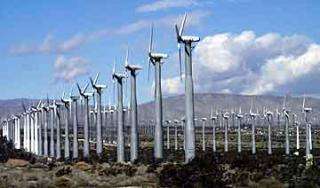MIT team analyzes wind energy potential in Northeast

There's more to determining the value of wind power than knowing which way the wind blows -- or even how hard. MIT researchers studying winds off the Northeast coast have found that estimating the potential environmental benefits from wind and other renewables requires a detailed understanding of the dynamics of both renewable resources and conventional power generation.
Data show that wind-energy facilities would generate far more electricity in winter, because that's when winds are strongest. But the need for electricity is greatest in summer, when air conditioners are going full blast.
So, what are the benefits of wind energy?
According to the MIT study, wintertime wind power will replace electricity generated by relatively inefficient and dirty fossil fuel power plants. However, since wind, electricity demand, fossil fuel prices and investment in power generation are so variable, the MIT team is now performing a more comprehensive analysis.
This work follows a similar study on solar power. In 2004, Stephen R. Connors and colleagues in the Laboratory for Energy and the Environment's Analysis Group for Regional Energy Alternatives (AGREA) reported that siting solar photovoltaic (PV) systems where sunshine is most abundant does not always lead to the biggest emissions savings. By looking at detailed historical data, they found that in some cases a more important factor is the emissions level of the conventional power plant that is being turned up or down in response to the available solar power.
Those findings elicited considerable interest from state regulators and power system operators who need hard estimates of potential emissions reductions from using local renewable resources, especially when there are local concerns over siting.
Now, Connors and Michael Berlinski, a graduate student in MIT's Engineering Systems Division, have turned their attention to the environmental benefits of using wind-energy systems off New England. As in the solar study, they performed intensive "data mining" using numerous National Oceanic and Atmospheric Administration (NOAA), Environmental Protection Agency and other data sources tracking windspeeds, electricity demand and power systems operations over time. Using hourly windspeeds collected by NOAA's network of data buoys, they calculated the electricity that could have come from various offshore sites had wind turbines been located there.
The data showed that the potential for wind-generated electricity is highest in the winter in the Northeast.
"You would think that wind power is not a good fit for New England because it's not there when you need it most -- midday during the summer when demand and prices are high," said Connors. "But from an emissions-reduction perspective it actually fits very well."
He and Berlinski found that in winter, fossil units with relatively high greenhouse gas and other emissions are more likely to be backed off, or turned down, when electricity from wind farms becomes available. Thus, when wind farms operate the most, they reduce the operation of some of New England's dirtiest conventional plants.
Comparing the solar and wind results highlights the importance of tracking the "mode" in which the power system is operating. In winter, when wind generation peaks, the power system is dominated by older, lower-cost plants burning coal or oil. In summer, when solar generation peaks, the power system includes more natural-gas-burning plants to meet high electricity demand. Because of their higher cost, natural gas plants will be backed off first. But natural gas plants are generally more fuel efficient than plants that burn other fossil fuels. Thus, the emissions reductions per kilowatt-hour will not be as dramatic.
"So here's the research challenge," said Connors. "Before we can calculate the true environmental benefits of using renewables, we need to be able to figure out the operating mode of the whole electric power system in a particular region and over time." The usual static data -- annual wind power and annual power plant emissions, for example -- are insufficient.
Source: MIT (by Nancy Stauffer)
















